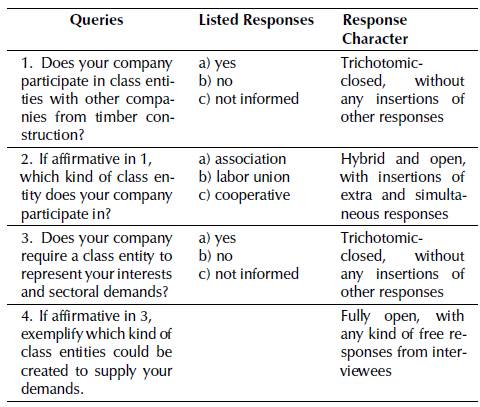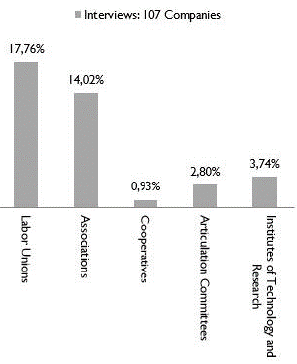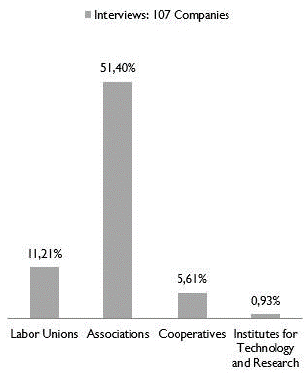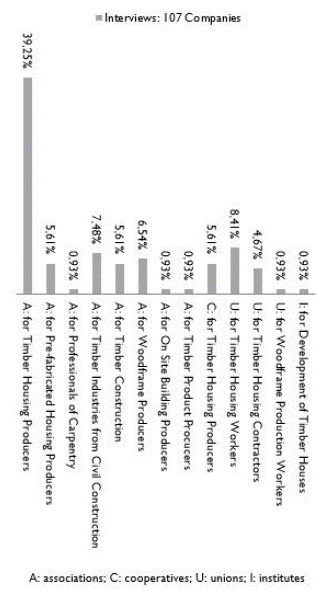Introduction
In order to survive in a competitive environment, an organization must face its challenges head-on, adapt, learn, change, and improve its features and conditions (Abou-Moghli and Al-Abdallah, 2018). However, business associative strategies can avoid this scenario under the mutual growth and institutional development. In Brazil, Jesus (2007) verified that, since the 1850s, when any popular group opted to start an association, people were forced to ask for special authorizations at the police station closest to the place of meeting. Today, this process can be carried out with standard guidebooks. For example, if there is public interest in a mobilization, according to Cardoso (2014), at least 10 people are required to create an official association. To this effect, the following stages must be respected: people sensitization, constitution of this future entity, pre-operation through entity structuration, and then, group operationalization and its respective activities.
In general, private organizations with public purposes are those formed by charity institutions, artistic entities, religious groups, professional associations, sectoral representatives, labor unions, and voluntary and community groups (Hudson, 1999).
Private organizations emerge when people from the civil society come together with the aim to consolidate resources and efforts to provide for social needs that cannot be efficiently maintained by the governments (Santos, Camargo, Giuliani, Novaes Netto, and Spers, 2010). Their purpose has been to promote general interests, taking on different legal forms and nomenclatures, and their origins related to the institutional formation and dynamics from each society (Andion, 2005).
Associations may be created due to administrative incompetence and/or lack of public policy to take measures and assign resources to address specific demands (Santos et al., 2010). An industrial association can play the role of a catalyst for change where public intervention does not provide responses to market failure in the development of innovation (Schwartz and Bar-El, 2015). In this way, inflexible laws and public institutions have affected firms' financial gains from corporate entrepreneurship (Vanacker, Zahra, and Holmes, 2017). Such groups are the path to business survival.
Class entities are established as strategic spaces to identify the actions of the economical elites, as well the character and direction of their interests (Loss, 2010). These associations -with distinct ends as scientific, cultural, professional, religious, or even, for charity or recreation- are created to organize, disclose or defend collective material, ideological, political or civil interests (Jesus, 2007). Such initiatives are based on community of origin, usually through a network of common relations (Doucet and Favreau, 1991).
The basic structure of professional or class associations includes the activities related to corporate and employer organizations, professional associations, and labor unions (Salamon and Anheier, 1996). Santos et al. (2010) classified these groups according to their endogenous nature, in the case of activities that benefit their membership -for example, class and employer associations- or exogenous, when they seek a public goods in favor of external people from its social board -such as labor unions.
The regulation of employer and worker classes in Brazil was established by the Decree 19 770, which determined that class associations may be designated as labor unions, federations, and confederations. Their scopes can be local, state-wide and national, respectively (Brazil, 1931). Labor unions emerged in the context of the Industrial Age, in the face of claims to defend workers' rights (Loureiro, 1967). Union actions are not limited to economic and political aspects, but also include the field of formation -in favor of recent knowledge- citizen autonomy, political sense, and politicization, in order overcome the emerging challenges of the capitalist world (Soares and Cabral, 2012).
With a business perspective, Santos et al. (2010) highlighted that associations aim to promote benefits to their members such as providing several services, gaining influence together with local public agencies, uniting representative forces to generate bargaining power with suppliers, and other purposes.
At the end of 1800s, small industrialists from northern Portugal, who felt marginalized in a group dominated by representatives of large textile factories, came together to create the Porto Union of Industrialists to defend national work (Alves, 1996).
Today, most of the existing professions in society rely on associative movements and class entities (Ribeiro, Miranda, and Reis, 2015). Nevertheless, in contrast, different sectors remain unmotivated to join forces in order to obtain representation.
In Brazil, for instance, some niches, such as the timber housing production sector, still do not have direct representation, either for workers or even for construction entrepreneurs. Thus, in parallel with the Brazilian civil construction scenario, some councils, unions and associations focused on this purpose have directed their actions to a group that produces masonry-based buildings, in other words, to the detriment of other construction techniques. In view of this visible exclusion, the creation of representative organizations for all producers and workers from timber housing construction becomes necessary.
This is justified in relation to all the difficulties derived from forest-timber activities, which are very different compared to the obstacles faced by masonry housing producers. Additional information to contribute to the development of small and unrepresented industrial sectors is required. A good effort could be supported by scientific studies.
Industrial studies contribute with information from surveys about production sectors, promoting their knowledge and development. According to the National Institute of Industrial Property (2019), this strategic information on specific sectors is determined to subsidize the elaboration of new regulatory acts to support in the sectoral evaluation of the results from industrial policies, and to allow better utilization of every resource to promote research, development, and technological innovation.
Several studies emerged to supply sectoral issues, as well as to contribute to industry development (Zamora, Delgado, and Sarache, 2014; Pena-Montoya, Osorio-Gomez, Vidal-Holguin, Torres-Lozada, and Marmolejo-Rebellon, 2015; UN/ICC 2015; García-Alcaraz, Adarme-Jaimes, and Blanco-Fernández, 2016;, Vanacker et al., 2017; De Araujo et al., 2018a,b,c; Martins, Steiner, Wilhem, Steiner Neto, and Santos, 2018; Realy Vásquez, Maldonado-Macías, García-Alcaraz, 2018; Vishwakarma, Nema, and Sangle, 2018, and others).
The present study aimed to investigate the effective participation of Brazilian timber housing producers in generalist organizations as well as to determine which kinds of class entities could be created to represent and defend the rights and ambitions of this sector. Some hypotheses were listed: most of producers are not part of any organization; the adhesion to general unions of civil construction is still low; and, there is a demand to create an entity to represent timber housing companies and activities.
Experimental development
Given the inexistence of official class entities for Brazilian timber housing producers, any study about this sector becomes limited and arduous, due to the lack of such institutions to share data and information on their respective activities. Therefore, this paper was extracted from a wide research, performed by De Araujo (2017), which aimed to identify and detail the industry, considering the present misinformation in Brazil.
Field of study and considerations
The first stage of this wide research, designed and performed by De Araujo (2017), included the preparation of a list with existing Brazilian timber house producers. After the identification and location of such companies, different information could be obtained, such as the size of the sector and its concentration, that is, the amount of national producers and the state regions with a larger amount of producers. This stage was based on searches on websites from those companies that were prospected for this list, ranging from artisanal to fully industrial productions. This procedure was based on De Araujo et al. (2018a,b,c). After this estimation, the sampling was carried out to characterize the producers in detail and, specifically for the present paper, to verify demands regarding class entities that represent this domestic production sector, since several companies could be prospected and identified in Brazil. Since the studied period, no research has revealed an updated sectoral size, although this totality is still basically active in 2020.
Sampling had limitations in data collection, since face-to-face interviews were carried out with entrepreneurs, either at their company headquarters, at construction events or in timber fields. Due to the large extension of the Brazilian territory, distant regions could imply higher locomotion costs and, consequently, they would be the main limiting factor to the research performance. Thus, a macro-region was designed and considered for data collection, which was based on the largest amount of producers. Such considerations are in the line with the path established by De Araujo (2017) and followed by De Araujo et al. (2018a,b,c).
Survey method and data collection
This study consisted of a survey aiming reveal the real and current situation of the timber house production sector with respect to their representatives and class entities in Brazil. Four questions were formulated for the sampled population to characterize the context in question. The approach and application were in charge of the research manager (first author) and his advisor (last author), with formal support of some researchers from the construction and timber fields (co-authors). A semi-structured questionnaire was created, and its queries are cited and explained in Table 1.
Questions 1 and 3 were fully closed and designed to obtain only three possible answers, which could reveal the real panorama of the existence of class entities or their requirement, respectively.
In the second question, only the interviewees who answered 'yes' in the first query could participate, and they were encouraged to answer with the type of group in which their companies are involved. This question is hybrid due to the lack of knowledge of this sector. Finally, the fourth query was created to collect free answers from interviewees regarding the type of organizations they need at this present moment (Table 1). The conclusion of this research was supported by the collected data from timber housing producers, whose qualitative responses were converted into percentage, in order to measure the respective representation and to contribute with assertive discussions for a better sectoral understanding of the prospected scenario.
Statistical method
To validate the obtained results and, consequently, the sampling surveyed in this study, a margin of error was set. For this, the online software for statistical samplings 'Raosoft Sample Size Calculator' from Raosoft (2004) was used to determine the sampling coverage under software prescriptions (a 95% confidence level and a 50% response distribution). A margin of error was obtained and compared with existing literature to certify and validate the research.
Results and Discussion
The performance of this sampling reached 50,95% of the whole sectoral population, as was also declared by De Araujo et al. (2018 a,b,c) with a ± 3,325% margin of error. Also, this statistical tool validated this survey using the definitions by Pinheiro, Castro, Silva, and Nunes (2011), which included two possible levels of reliability to be achieved: acceptable (± 5%) and ideal (± 2,5%).
Table 2. Details of survey and sampling
Source: De Araujo (2017) and De Araujo et al. (2018a, b, c).
The verification of a formal presence (by timber house producers) revealed that an expressive parcel of this sampling does not have any participative relationship, even in generalist organizations. Only a small amount of the sampled population did not share data (Figure 1a and Query 1). Thus, the study was quite below the ± 3,325% margin of error.
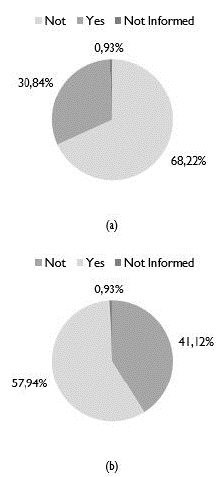
Source: Authors
Figure 1 Class entities: (a) formal participation (Query 1) and (b) sectoral demand (Query 3) from sampled producers.
This situation contrasts with a visible demand for the creation of some kind ofrepresentation for this sector, either corporate or from a labor perspective; over the half of the sampled companies feel a lack of representation to cluster all timber house producers in Brazil (Figure 1b and Query 3). This need for a better representation is identified by Lawton, Rajwani, and Minto (2018), since associations are made up of multiple individuals and organizations working toward a shared purpose.
Due to the lack of organizations that are reportedly focused on the timber housing production sector, several companies were motivated to participate in entities from other related activities (Figure 1a).
Thus, associations and labor unions evinced greater adherence among the sampled producers (Figure 2 and Query 2). However, a small portion of the sampled population still officially and strategically declared to be part of technology and research institutes, committees for production and sectoral articulation, and also production cooperatives (Figure 2 and Query 2). This panorama suggests that some companies -in a context lacking representation- have adhered to other distinct sectors to strengthen each other. In view of this problem, associations from different industrial groups have been requested by Brazilian timber house producers to supply this perceived absence, for example, entities from civil construction (mainly focused on masonry), forest production, sawmilling, woodworking, furniture, wood preservation, pulp and paper, general trading, etc. Despite this chronic fact, such producers have been looking for a way to feel more represented because, according to Padilha (2013), class entities have been always created to congregate professionals and to allow actions in defense of specific interests, such as market reserve, fee tables, political lawsuits, etc.
Regarding the demand for greater specific representation, the studied companies reported that associations constitute a basic and immediate need, by virtue of visible claim and pretensions from the timber housing production sector (Figure 3 and Query 4). Thus, the result was more telling when compared to other studies due to the specific focus on class associations, which are meant to represent and defend corporate rights. Due to these noticeable sectoral lacks, the establishment of labor unions was the second essential demand, although its main purpose is to represent workers. This panorama also suggests that some companies are active in the campaign for workers' rights, which is quite rare in any industrial sector. A small portion of the sampled producers declared the need for the creation of cooperatives, as well as institutes for timber housing research and technology.
Thereupon, the entrepreneurs studied in this sampling pointed out those main demanded organizations (Figure 4 and Query 4). In this figure, the acronyms were used for associations (A), unions (U), cooperatives (C), and for institutes of research and technology (I). Timber housing producer associations were the most prominent in demand, including almost 40% of the interviewees. In a small scale, the studied companies also pointed out other associations and cooperatives focused on timbered construction techniques, wood product producers, woodframe technique builders, etc.
Due to sectoral disarticulation and informality, several producers still declared the need to create labor unions to represent their workers and professionals (Figure 4), denoting this Brazilian production sector' current lack of representation, which was characterized as the second main sectoral demand.
However, regarding the effectiveness of those listed alternatives, articulations will still be necessary, particularly among their future members and their political agendas, as well as public agencies, both in municipal, state and federal contexts.
Most likely, this turning point will be driven by the intensification of construction industrialization -a real phenomenon that is visible in the United States, Sweden, Germany, and Japan, as cited by Koones (2019)- under the need for new cluster formations among suppliers and producers.
In comparison with the current international panorama, several countries focused on the culture of timber utilization already possess class entities to represent their professionals, companies, and groups for science and technology of timber construction. A global perception reveals that several international entities from forest-timber fields are present in the United States, Canada, Germany, Finland, Sweden, Norway, Austria, Bosnia, Chile, New Zealand, Australia, etc. However, with respect to these studied producers, some countries concentrate entities for this purpose, for example, Lithuania (Mediniu Namu Gamintoju Asociacija, 2007), Estonia (Eesti Puitmajaliit, 2009), and Spain (Asociación de Fabricantes y Constructores de Casas de Madera, 2009).
Conclusions
Formerly, timber housing producers had no official class entities in Brazil, and this situation remains similar in 2020. This fact has forced such companies to seek representation in related sectors, for example, some generalist groups for trade and industry, civil construction (essentially in masonry and steel), or even, in some different associations for other forest and timber activities, which include sylviculture, sawmilling, furniture, wood preservation, etc. This mechanism is rather limited, since most of these entities are not set in the context of timber housing companies, which have domestic presence since the late 1800s.
This lack of representation is noticeable, either from corporative or labor perspectives, that it motivates the sampled entrepreneurs to declare the immediate need to effectively create associations for these producers, as well as labor unions for their workers.
Given the lack of proposals, some new suggestions were listed to create representation and associative channels among producers and workers of the Brazilian timber housing construction sector. These suggestions aimed to organize and represent the industry in order to defend their needs and interests, together with the national government, with respect to technological improvement, market consolidation, and stimuli for new operations. Associations and cooperatives have been demanded, both for producers and workers, to represent different types of construction techniques, prefabricated houses, timber products, and carpentry.














